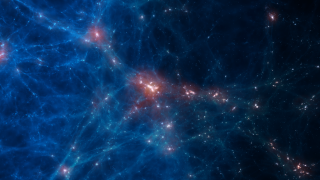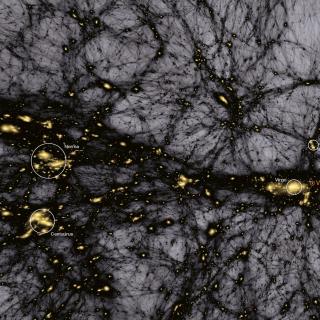Bibcode
Yajima, H.; Nagamine, Kentaro; Zhu, Qirong; Khochfar, Sadegh; Dalla Vecchia, C.
Referencia bibliográfica
The Astrophysical Journal, Volume 846, Issue 1, article id. 30, 13 pp. (2017).
Fecha de publicación:
9
2017
Revista
Número de citas
44
Número de citas referidas
36
Descripción
Recent observations have detected galaxies at high-redshift z∼
6{--}11, and revealed the diversity of their physical properties, from
normal star-forming galaxies to starburst galaxies. To understand the
properties of these observed galaxies, it is crucial to understand the
star formation (SF) history of high-redshift galaxies under the
influence of stellar feedback. In this work, we present the results of
cosmological hydrodynamic simulations with zoom-in initial conditions,
and investigate the formation of the first galaxies and their evolution
toward observable galaxies at z∼ 6. We focus on three different
galaxies that end up in halos with masses {M}{{h}}=2.4×
{10}10 {h}-1 {M}ȯ (Halo-10),
1.6× {10}11 {h}-1 {M}ȯ
(Halo-11), and 0.7× {10}12 {h}-1
{M}ȯ (Halo-12) at z = 6. Our simulations also probe the
impacts of different subgrid assumptions, i.e., SF efficiency and cosmic
reionization, on SF histories in the first galaxies. We find that SF
occurs intermittently due to supernova (SN) feedback at z≳ 10, and
then it proceeds more smoothly as the halo mass grows at lower
redshifts. Galactic disks are destroyed due to SN feedback, while
galaxies in simulations with no feedback or lower SF efficiency models
can sustain a galactic disk for long periods ≳ 10 {Myr}. The
expulsion of gas at the galactic center also affects the inner dark
matter density profile for a short period. Our simulated galaxies in
Halo-11 and Halo-12 reproduce the SF rates and stellar masses of
observed Lyα emitters at z∼ 7{--}8 fairly well given the
observational uncertainties.
Proyectos relacionados

Astrofísica Numérica: Formación y Evolución de Galaxias
Entre las cuestiones fundamentales en Astronomía y Astrofísica están la formación y evolución de galaxias. Las escalas de tiempo y tamaño son tan astronómicas que su observación en galaxias individuales es imposible. Solo con el uso de simulaciones numéricas es posible entender la formación de estructuras cósmicas dentro del actual marco
Claudio
Dalla Vecchia

Cosmología con Trazadores de la Estructura a Gran Escala del Universo
El Fondo Cósmico de Microondas (FCM) contiene la información estadística de las semillas primigenias que han dado lugar a la formación de todas las estructuras en el Universo. Su contrapartida natural en el Universo local es la distribución de las galaxias que surgen como resultado del crecimiento gravitatorio de aquellas fluctuaciones de densidad
FRANCISCO SHU
KITAURA JOYANES